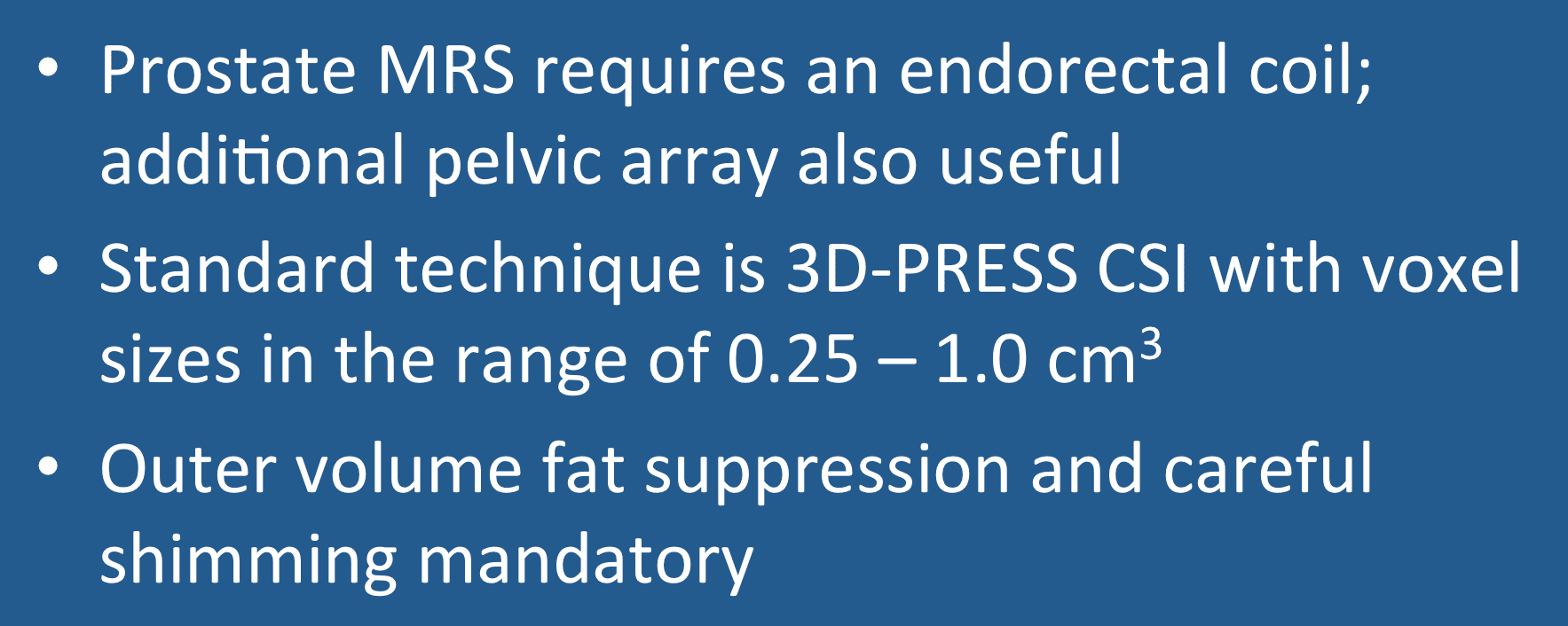¹H spectroscopy of the prostate is focused on the detection and localization of cancer. Although having some independent value, MRS is probably best used as part of a multi-parametric assessment that includes DWI, DCE-MRI, and conventional T2-weighted imaging.
 Outer volume suppression bands (yellow) and 3D-CSI grid
Outer volume suppression bands (yellow) and 3D-CSI gridplaced over the prostate.
Due to its small size and deep location embedded in pelvic fat, MRS of the prostate is challenging. Both endorectal and pelvic phased-array coils are needed for maximum signal-to-noise. Manual shimming is generally recommended in addition to automated shimming to improve the quality of spectroscopic data acquired.
Thin-section, high-resolution, multi-planar T2-weighted images serve both diagnostic purposes and as spectroscopic localizers. Outer volume saturation (OVS) bands should be tightly placed around the gland in all three dimensions to exclude signal from pelvic fat and from fluid in the seminal vesicles.
Thin-section, high-resolution, multi-planar T2-weighted images serve both diagnostic purposes and as spectroscopic localizers. Outer volume saturation (OVS) bands should be tightly placed around the gland in all three dimensions to exclude signal from pelvic fat and from fluid in the seminal vesicles.
Because of the prostate's small size and the fact that early cancers occupy only a portion of the gland, multi-voxel spectroscopic imaging is required. The recommended sequence is 3D-PRESS with voxels 6-10 mm on each side (i.e., voxel volumes 0.25−1.0 cm³). TR is kept short (~1000 ms) to reduce imaging time, which may still exceed 20+ minutes per acquisition, not including setup. TE depends both on TR and field strength, but is usually set to ~125 ms at 1.5T. Additional fat and water suppression can be obtained by incorporating BASING (BAnd Selective Inversion with gradient dephasiNG) and/or MEGA (MEscher-GArwood) pulses into the middle of the PRESS sequence.
Advanced Discussion (show/hide)»
Additional Tips for a Good Prostate MRS Exam
Instead of air, the endorectal coil balloon should be filled with 40-60 cc of liquid such as barium sulfate to reduce susceptibility-induced magnetic field distortions.
To reduce motion, patient should empty his bladder before the examination, and rectum should be clensed. Intramuscular glucagon may be useful to reduce bowel peristalsis.
If both endorectal and pelvic phased-array coils are used, then only those coil elements of the pelvic array closest to the prostate should be activated. The other elements will only add noise if used.
Turbo Spectroscopic imaging cannot be used in the prostate because of the complex J-coupling evolution of the citrate signal.
References
Mescher M, Tannus A, O’Neil Johnson M, Garwood M. Solvent suppression using selective echo dephasing. J Magn Reson A 1996; 123:226–229. (First description of the MEGA technique)
Scheenen TWJ, Gambarota G, Weiland E, et al. Optimal timing for in vivo ¹H-MR spectroscopic imaging of the human prostate at 3T. Magn Reson Med 2005; 53:1268-1274.
Sharma S. Imaging and intervention in prostate cancer: current perspectives and future trends. Indian J Radiol Imaging 2014; 24:139-148. (Reviews the relative utility of multiple modalities and MR techniques for the diagnosis of prostate cancer).
Star-Lack J, Nelson SJ, Kurhanewicz J, et al. Improved water and lipid suppression for 3D PRESS CSI using RF band selective inversion with gradient dephasing (BASING). Magn Reson Med. 1997; 38:311–321.
Verma S, Rajesh A, Fütterer JJ, et al. Prostate MRI and 3D MR spectroscopy: how we do it. AJR Am J Roentgenol 2010; 194:1414-1426. (Excellent technical review, giving recommended MRS parameters based on field strength and scanner brand).
Mescher M, Tannus A, O’Neil Johnson M, Garwood M. Solvent suppression using selective echo dephasing. J Magn Reson A 1996; 123:226–229. (First description of the MEGA technique)
Scheenen TWJ, Gambarota G, Weiland E, et al. Optimal timing for in vivo ¹H-MR spectroscopic imaging of the human prostate at 3T. Magn Reson Med 2005; 53:1268-1274.
Sharma S. Imaging and intervention in prostate cancer: current perspectives and future trends. Indian J Radiol Imaging 2014; 24:139-148. (Reviews the relative utility of multiple modalities and MR techniques for the diagnosis of prostate cancer).
Star-Lack J, Nelson SJ, Kurhanewicz J, et al. Improved water and lipid suppression for 3D PRESS CSI using RF band selective inversion with gradient dephasing (BASING). Magn Reson Med. 1997; 38:311–321.
Verma S, Rajesh A, Fütterer JJ, et al. Prostate MRI and 3D MR spectroscopy: how we do it. AJR Am J Roentgenol 2010; 194:1414-1426. (Excellent technical review, giving recommended MRS parameters based on field strength and scanner brand).
Related Questions
How do you interpret spectra from the prostate?
How and why is fat suppression performed in an MRS study?
How do you interpret spectra from the prostate?
How and why is fat suppression performed in an MRS study?
